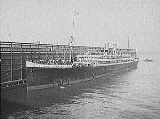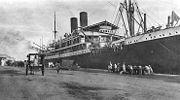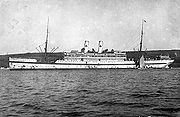
Barbarossa class ocean liner
Encyclopedia
| Passengers: |
The Barbarossa class was a class
Ship class
A ship class is a group of ships of a similar design. This is distinct from a ship-type, which might reflect a similarity of tonnage or intended use. For example, the is a nuclear aircraft carrier of the Nimitz class....
of ocean liner
Ocean liner
An ocean liner is a ship designed to transport people from one seaport to another along regular long-distance maritime routes according to a schedule. Liners may also carry cargo or mail, and may sometimes be used for other purposes .Cargo vessels running to a schedule are sometimes referred to as...
s of North German Lloyd and the Hamburg America Line
Hamburg America Line
The Hamburg Amerikanische Packetfahrt Actien Gesellschaft was a transatlantic shipping enterprise established in Hamburg, Germany during...
of the German Empire
German Empire
The German Empire refers to Germany during the "Second Reich" period from the unification of Germany and proclamation of Wilhelm I as German Emperor on 18 January 1871, to 1918, when it became a federal republic after defeat in World War I and the abdication of the Emperor, Wilhelm II.The German...
. Of the ten ships built between 1896 and 1902, six were built by AG Vulcan Stettin, three were built by Blohm & Voss, and one was built by F. Schichau; all were built in Germany. They averaged and featured twin screw propellers driven by quadruple-expansion steam engines.
Early career
The first four ships of the class, , , , and were launchedShip naming and launching
The ceremonies involved in naming and launching naval ships are based in traditions thousands of years old.-Methods of launch:There are three principal methods of conveying a new ship from building site to water, only two of which are called "launching." The oldest, most familiar, and most widely...
in 1896 for North German Lloyd ( or NDL) in a combination class usable on several of NDL's routes. The class was intended to be called the Bremen class but delays in the building of that ship caused the class to instead be named after Barbarossa. Despite the name of the class, the first ship launched was Friedrich der Grosse in August—at , the first German ship over —followed by Barbarossa, Königin Luise, and Bremen at monthly intervals. These first four ships were used on Australia
Australia
Australia , officially the Commonwealth of Australia, is a country in the Southern Hemisphere comprising the mainland of the Australian continent, the island of Tasmania, and numerous smaller islands in the Indian and Pacific Oceans. It is the world's sixth-largest country by total area...
n, Far East
Far East
The Far East is an English term mostly describing East Asia and Southeast Asia, with South Asia sometimes also included for economic and cultural reasons.The term came into use in European geopolitical discourse in the 19th century,...
, and North Atlantic routes for NDL. On Australian and Far East voyages, the liners transited the Suez Canal
Suez Canal
The Suez Canal , also known by the nickname "The Highway to India", is an artificial sea-level waterway in Egypt, connecting the Mediterranean Sea and the Red Sea. Opened in November 1869 after 10 years of construction work, it allows water transportation between Europe and Asia without navigation...
, and were, along with NDL's ,Putnam (p. 140–42) includes "Grosse Kurfürst" as a Barbarossa-class ship, but Drechsel (p. 165) calls her an "only-vessel". Grosser Kurfürst was almost larger than the other Barbarossa-class ships and a full 10 metres (32.8 ft) longer, supporting Drechsel's view. (See Drechsel, p. 232.) the largest ships regularly using the canal. The size of these liners was a principal reason for the canal's deepening; Bremen, on one trip to Australia, became the first ship to transit the newly deepened canal.
The latter six ships, two for NDL and four for the Hamburg America Line
Hamburg America Line
The Hamburg Amerikanische Packetfahrt Actien Gesellschaft was a transatlantic shipping enterprise established in Hamburg, Germany during...
(German: Hamburg-Amerikanische Packetfahrt-Aktien-Gesellschaft or HAPAG) were launched between June 1899 and November 1901. NDL's two liners, and were launched a year apart in June 1899 and June 1900, respectively, and were used on Far East and North Atlantic routes. Beginning in 1904 they were mainly used on the Italy - New York route.
Of the four HAPAG liners, two, and , were launched in November 1899 and September 1900 for the Far East mail routes that HAPAG and NDL shared. Displeased with the Far East service, HAPAG withdrew and transferred Hamburg to North Atlantic service and traded Kiautschou to NDL for five freighter
Cargo ship
A cargo ship or freighter is any sort of ship or vessel that carries cargo, goods, and materials from one port to another. Thousands of cargo carriers ply the world's seas and oceans each year; they handle the bulk of international trade...
s in 1904. Kiautschou, renamed by NDL to Princess Alice, became the only Barbarossa-class ship to sail for both of the major German passenger lines. She stayed on the Far East mail route until 1914.

South America
South America is a continent situated in the Western Hemisphere, mostly in the Southern Hemisphere, with a relatively small portion in the Northern Hemisphere. The continent is also considered a subcontinent of the Americas. It is bordered on the west by the Pacific Ocean and on the north and east...
n routes.
World War I
At the outbreak of World War IWorld War I
World War I , which was predominantly called the World War or the Great War from its occurrence until 1939, and the First World War or World War I thereafter, was a major war centred in Europe that began on 28 July 1914 and lasted until 11 November 1918...
, rather than face capture or destruction at the hands of the British Royal Navy
Royal Navy
The Royal Navy is the naval warfare service branch of the British Armed Forces. Founded in the 16th century, it is the oldest service branch and is known as the Senior Service...
, most of the Barbarossa-class ships were interned in neutral ports. König Albert and Moltke were interned at Genoa
Genoa
Genoa |Ligurian]] Zena ; Latin and, archaically, English Genua) is a city and an important seaport in northern Italy, the capital of the Province of Genoa and of the region of Liguria....
, while Blücher was interned at Pernambuco
Pernambuco
Pernambuco is a state of Brazil, located in the Northeast region of the country. To the north are the states of Paraíba and Ceará, to the west is Piauí, to the south are Alagoas and Bahia, and to the east is the Atlantic Ocean. There are about of beaches, some of the most beautiful in the...
, Brazil
Brazil
Brazil , officially the Federative Republic of Brazil , is the largest country in South America. It is the world's fifth largest country, both by geographical area and by population with over 192 million people...
. Five ships were interned at U.S.-controlled ports: four—Barbarossa, Friedrich der Grosse, Prinzess Irene, and Hamburg—were interned at Hoboken, New Jersey
Hoboken, New Jersey
Hoboken is a city in Hudson County, New Jersey, United States. As of the 2010 United States Census, the city's population was 50,005. The city is part of the New York metropolitan area and contains Hoboken Terminal, a major transportation hub for the region...
, and Princess Alice was interned at Cebu
Cebu
Cebu is a province in the Philippines, consisting of Cebu Island and 167 surrounding islands. It is located to the east of Negros, to the west of Leyte and Bohol islands...
, Philippine Islands
Philippines
The Philippines , officially known as the Republic of the Philippines , is a country in Southeast Asia in the western Pacific Ocean. To its north across the Luzon Strait lies Taiwan. West across the South China Sea sits Vietnam...
. Only Königin Luise and Bremen were in German ports, where they remained throughout the war. In September 1914, Hamburg was briefly renamed and chartered to the American Red Cross
American Red Cross
The American Red Cross , also known as the American National Red Cross, is a volunteer-led, humanitarian organization that provides emergency assistance, disaster relief and education inside the United States. It is the designated U.S...
. Sailing under the name Red Cross, she made one roundtrip voyage to Europe before returning to New York, and her previous name.
As Italy, the United States, and Brazil successively joined the war, each seized the interned Barbarossa ships (along with all other German and Austro-Hungarian
Austria-Hungary
Austria-Hungary , more formally known as the Kingdoms and Lands Represented in the Imperial Council and the Lands of the Holy Hungarian Crown of Saint Stephen, was a constitutional monarchic union between the crowns of the Austrian Empire and the Kingdom of Hungary in...
ships) and renamed them. In Italy, Moltke became Pesaro, while König Albert became hospital ship
Hospital ship
A hospital ship is a ship designated for primary function as a floating medical treatment facility or hospital; most are operated by the military forces of various countries, as they are intended to be used in or near war zones....
Ferdinando Palasciano; in Brazil, Blücher became Leopoldina. The five ships interned under U.S. control all became United States Navy
United States Navy
The United States Navy is the naval warfare service branch of the United States Armed Forces and one of the seven uniformed services of the United States. The U.S. Navy is the largest in the world; its battle fleet tonnage is greater than that of the next 13 largest navies combined. The U.S...
transport ships, and were renamed as follows:

- Barbarossa became USS Mercury (ID-3012)
- Friedrich der Grosse became USS Huron (ID-1408)
- Prinzess Irene became USS Pocahontas (ID-3044)
- Hamburg became USS Powhatan (ID-3013)
- Princess Alice became USS Princess Matoika (ID-2290)
These five ex-German transports carried over 95,000 American troops to France before the Armistice.
Postwar service
At the conclusion of World War I, war reparationsWorld War I reparations
World War I reparations refers to the payments and transfers of property and equipment that Germany was forced to make under the Treaty of Versailles following its defeat during World War I...
permanently assigned the eight seized ships to the nations that held them. Further, Königin Luise and Bremen, safely laid up in Germany during the war, were assigned to the UK. Apart from those two, only two other Barbarossa-class ships changed national registry after the war. Brazil sold Leopoldina (the ex-Blücher) to the French
France
The French Republic , The French Republic , The French Republic , (commonly known as France , is a unitary semi-presidential republic in Western Europe with several overseas territories and islands located on other continents and in the Indian, Pacific, and Atlantic oceans. Metropolitan France...
Compagnie Générale Transatlantique
Compagnie Générale Transatlantique
The Compagnie Générale Transatlantique , typically known overseas as the French Line, was a shipping company established during 1861 as an attempt to revive the French merchant marine, the poor state of which was indicated during the Crimean War of 1856...
which operated her under the name Suffren. Pocahontas (the ex-Prinzess Irene) was laid up in Gibraltar
Gibraltar
Gibraltar is a British overseas territory located on the southern end of the Iberian Peninsula at the entrance of the Mediterranean. A peninsula with an area of , it has a northern border with Andalusia, Spain. The Rock of Gibraltar is the major landmark of the region...
after mechanical failures and was purchased by NDL in 1923. She became the only member of the Barbarossa class to resume sailing under the German flag. First renamed Bremen and later Karlsruhe (to free the name Bremen for a newer ship
SS Bremen (1929)
The SS Bremen was a German-built ocean liner constructed for the Norddeutscher Lloyd line to work the transatlantic sea route. The Bremen was notable for her bulbous bow construction, high-speed engines, and low, streamlined profile. At the time of her construction, she and her sister ship were...
), she sailed primarily on the Bremen–New York route.
In 1922, City of Honolulu (the ex-Friedrich der Grosse), sailing on her first roundtrip on the Los Angeles
Los Angeles, California
Los Angeles , with a population at the 2010 United States Census of 3,792,621, is the most populous city in California, USA and the second most populous in the United States, after New York City. It has an area of , and is located in Southern California...
–Honolulu
Honolulu, Hawaii
Honolulu is the capital and the most populous city of the U.S. state of Hawaii. Honolulu is the southernmost major U.S. city. Although the name "Honolulu" refers to the urban area on the southeastern shore of the island of Oahu, the city and county government are consolidated as the City and...
route for the Los Angeles Steamship Company
Los Angeles Steamship Company
The Los Angeles Steamship Company or LASSCO was a passenger and freight shipping company based in Los Angeles, California. The company, formed in 1920, initially provided fast passenger service between Los Angeles and San Francisco...
, caught fire and burned in a calm sea. No one on board was killed or injured when the lifeboats were launched, and when towing the burned hulk proved unsuccessful, the ship was sunk by gunfire from a United States Coast Guard Cutter
United States Coast Guard Cutter
Cutter is the term used by the United States Coast Guard for its commissioned vessels. A Cutter is or greater in length, has a permanently assigned crew, and has accommodations for the crew to live aboard...
; she was the only member of the Barbarossa class to sink. By the end of the 1920s, six more Barbarossa ships had met their ends at the hands of shipbreakers, and none of the remaining three ships would survive the next decade. All were scrapped by 1935, bringing an end to the career of the Barbarossa class.
The ships
| Ship | Tonnage | Builder | Original Operator |
Launch | Fate | Later names |
|---|---|---|---|---|---|---|
| AG Vulcan | NDL | Huron, 1917 City of Honolulu, 1922 |
||||
| Blohm & Voss | NDL | Scrapped, 1924 | Mercury, 1917 | |||
| AG Vulcan | NDL | Scrapped, 1935 | Omar, 1921 Edison, 1924 |
|||
| F. Schichau | NDL | Scrapped, 1929 | Constantinople, 1921 King Alexander, 1924 |
|||
| AG Vulcan | NDL | Scrapped, 1926 | Ferdinando Palaciano, 1915 Italia, 1922 |
|||
| AG Vulcan | HAPAG | Scrapped, 1928 | Powhatan, 1917 New Rochelle, 1920 Hudson, 1921 President Fillmore, 1922 |
|||
| AG Vulcan | NDL | Scrapped, 1932 | Pocahontas, 1917 Bremen, 1923 Karlsruhe, 1928 |
|||
| AG Vulcan | HAPAG | Scrapped, 1934 | Princess Alice, 1904 Princess Matoika, 1918 President Arthur, 1923 City of Honolulu, 1926 |
|||
| Blohm & Voss | HAPAG | Scrapped, 1925 | Pesaro, 1919 | |||
| Blohm & Voss | HAPAG | Scrapped, 1929 | Leopoldina, 1917 Suffren, 1923 |
|||

